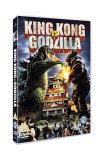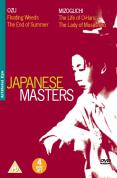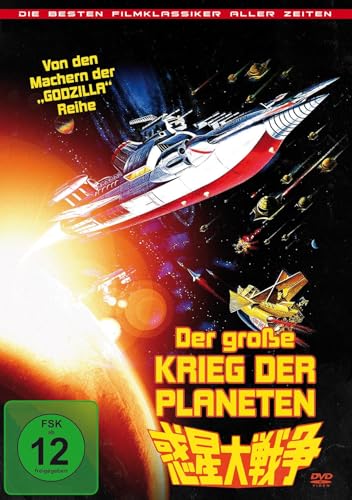![Godzilla [1954]](/pictures/1036979.jpg) Godzilla | DVD | (13/02/2006)
from £31.95
| Saving you £-11.96 (N/A%)
| RRP
Godzilla | DVD | (13/02/2006)
from £31.95
| Saving you £-11.96 (N/A%)
| RRP The legend begins... Released to coincide with the film's 50th anniversary - the original unexpurgated uncut and subtitles version of the film has rarely seen by British audiences. After American nuclear testing in the Pacific Ocean several ships are sunk in mysterious circumstances. The Japanese authorities close in on the neaby Odo island where natives relate tales of a devastating monster whom they call 'Gojira'. An expedition to the island by Professor Kyohei Yamane (Shi
![King Kong Vs Godzilla [Blu-ray]](/pictures/1142527.jpg) King Kong Vs Godzilla | Blu Ray | (20/02/2017)
from £19.29
| Saving you £N/A (N/A%)
| RRP
King Kong Vs Godzilla | Blu Ray | (20/02/2017)
from £19.29
| Saving you £N/A (N/A%)
| RRP Ishiro Honda directs this classic Japanese sci-fi adventure featuring a clash of the cinematic titans as King Kong and Godzilla square off for a monster showdown. At the same time as a pharmaceutical company manager undertakes an expedition in search of the mystical berries that confer gigantic size on the legendary Kong, a team of American pilots have discovered the frozen tomb of the fearsome Godzilla. When they thaw him out, the stage is set for a titanic battle between the two oversized creatures.
![Godzilla [4K UHD + Blu-Ray] (Criterion Collection) - UK Only](/pictures/1167002.jpg) Godzilla | Blu Ray | (11/11/2024)
from £29.99
| Saving you £N/A (N/A%)
| RRP
Godzilla | Blu Ray | (11/11/2024)
from £29.99
| Saving you £N/A (N/A%)
| RRP Godzilla (a.k.a. Gojira) is the roaring granddaddy of all monster movies. It's also a remarkably humane and melancholy drama, made in Japan at a time when the country was reeling from nuclear attack and H-bomb testing in the Pacific. Its rampaging radioactive beast, the poignant embodiment of an entire population's fears, became a beloved international icon of destruction, spawning more than thirty sequels. A thrilling, tactile spectacle that continues to be a cult phenomenon, the original 1954 Japanese version is presented here, along with Godzilla, King of the Monsters, the 1956 Americanized version.Film Info¢ Japan¢ 1954¢ 96 minutes¢ Black & White¢ 1.37:1¢ Japanese¢ Spine #5944K UHD + BLU-RAY SPECIAL EDITION FEATURES¢ New 4K digital restoration, with uncompressed monaural soundtrack¢ [4k ONLY] One 4K UHD disc of the film and one Blu-ray with the film and special features¢ High-definition digital restoration of Godzilla, King of the Monsters, Terry Morse's 1956 reworking of the original, with uncompressed monaural soundtrack¢ Audio commentary for both movies by film historian David Kalat¢ Interviews with actors Akira Takarada and Haruo Nakajima and special effects technicians Yoshio Irie and Eizo Kaimai¢ Interview with legendary Godzilla score composer Akira Ifukube¢ Featurette detailing Godzilla's photographic effects, introduced by special effects director Koichi Kawakita and special effects photographer Motoyoshi Tomioka¢ Interview with Japanese-film critic Tadao Sato¢ The Unluckiest Dragon, an illustrated audio essay featuring historian Greg Pflugfelder describing the tragic fate of the fishing vessel Daigo Fukuryu Maru, a real-life event that inspired Godzilla¢ Trailers¢ PLUS: An essay by critic J. Hoberman¢ Cover by Bill Sienkiewicz
![Godzilla (Criterion Collection) UK Only [Blu-ray]](/pictures/1167106.jpg) Godzilla (Criterion Collection) UK Only | Blu Ray | (11/11/2024)
from £14.99
| Saving you £N/A (N/A%)
| RRP
Godzilla (Criterion Collection) UK Only | Blu Ray | (11/11/2024)
from £14.99
| Saving you £N/A (N/A%)
| RRP Godzilla (a.k.a. Gojira) is the roaring granddaddy of all monster movies. It's also a remarkably humane and melancholy drama, made in Japan at a time when the country was reeling from nuclear attack and H-bomb testing in the Pacific. Its rampaging radioactive beast, the poignant embodiment of an entire population's fears, became a beloved international icon of destruction, spawning more than thirty sequels. A thrilling, tactile spectacle that continues to be a cult phenomenon, the original 1954 Japanese version is presented here, along with Godzilla, King of the Monsters, the 1956 Americanized version.Film Info¢ Japan¢ 1954¢ 96 minutes¢ Black & White¢ 1.37:1¢ Japanese¢ Spine #594¢ High-definition digital restoration of Godzilla, King of the Monsters, Terry Morse's 1956 reworking of the original, with uncompressed monaural soundtrack¢ Audio commentary for both movies by film historian David Kalat¢ Interviews with actors Akira Takarada and Haruo Nakajima and special effects technicians Yoshio Irie and Eizo Kaimai¢ Interview with legendary Godzilla score composer Akira Ifukube¢ Featurette detailing Godzilla's photographic effects, introduced by special effects director Koichi Kawakita and special effects photographer Motoyoshi Tomioka¢ Interview with Japanese-film critic Tadao Sato¢ The Unluckiest Dragon, an illustrated audio essay featuring historian Greg Pflugfelder describing the tragic fate of the fishing vessel Daigo Fukuryu Maru, a real-life event that inspired Godzilla¢ Trailers¢ PLUS: An essay by critic J. Hoberman¢ Cover by Bill Sienkiewicz
![Wasabi [2001]](/pictures/1015170.jpg) Wasabi | DVD | (18/08/2003)
from £9.99
| Saving you £10.00 (100.10%)
| RRP
Wasabi | DVD | (18/08/2003)
from £9.99
| Saving you £10.00 (100.10%)
| RRP This high-energy Dirty Harry in Japan stars Jean Reno (The Professional) as a maverick Paris cop with sledgehammer fists and a short temper. Promoted to sudden fatherhood when he "inherits" a spunky Japanese daughter (Ryoko Hirosue) he never knew, he becomes her droopy guardian angel, protecting her from an army of yakuza gangsters. Written and produced by Luc Besson, the former fashionista director of Euro-sleek shoot-'em-ups, this colorful B-movie blast is as gritty as an oil slick on a water slide but packed with explosive action. Director Gerard Krawczyk punctuates his gunfights with the Hong Kong school of recoil (bullets blast victims across the screen) and an undercurrent of humor. As long as you don't lean too hard on such niggling details as logic, legality, and the laws of physics, this silly, splashy, family bonding bulletfest is a spirited good time.
 King Kong vs Godzilla | DVD | (10/04/2006)
from £9.80
| Saving you £0.19 (1.94%)
| RRP
King Kong vs Godzilla | DVD | (10/04/2006)
from £9.80
| Saving you £0.19 (1.94%)
| RRP When a Japanese businessman named Mr. Tako hears that a native tribe on the island of Farou possesses abnormally large berries he sends his employees Sakuri and Furue to retrieve the fruit. Better yet he tells them to also capture King Kong a gorilla monster who has become gigantic as a result of eating the berries. On their way back to Japan the team wrestles to gain control over the enormous and powerful creature who breaks free just as another notorious monster Godzilla is r
![The Mysterians [1957]](/pictures/1042908.jpg) The Mysterians | DVD | (13/02/2006)
from £N/A
| Saving you £N/A (N/A%)
| RRP
The Mysterians | DVD | (13/02/2006)
from £N/A
| Saving you £N/A (N/A%)
| RRP Join mankind's most treacherous battle for survival! From the director of the original Kaiju classic Godzilla comes The Mysterians - available on DVD for the first time! After a Japanese town is totally destroyed the military arrive to investigate. They encounter a giant robot that is decimating everything in its path. A dome appears out of the ground and a group of scientists are invited to meet the alien Mysterians from the planet Mysteroid. The Mysterians have come in peace all they ask humanity for is three-square kilometers of land and the right to interbreed with Earth women to repopulate their species. Outraged at such a suggestion humanity declares war on the Mysterians which leads to the revelation of the aliens' sinister secrets. However Earth stands little chance against the technologically advanced beings unless a group of scientists can come up with a super weapon to use against them. The Mysterians was the first colour Japanese science fiction film to be shot in widescreen. The creative team responsible for Godzilla reunited for the production and the special effects are striking. Flying saucers zeppelin-type aircraft ray-gun blasts mass floods and violent explosions are fantastically executed setting the standard for model effects and science fiction art design for years to come. Vibrant and bursting with action The Mysterians is an arresting vision of futuristic warfare and a cautionary tale for the atomic age; a treat not only for robot fanatics and cult sci-fi film fans but one of Ishiro Honda's most celebrated and spectacular extravaganzas.
 AD Police | DVD | (16/08/2004)
from £N/A
| Saving you £N/A (N/A%)
| RRP
AD Police | DVD | (16/08/2004)
from £N/A
| Saving you £N/A (N/A%)
| RRP Mega Tokyo: 2027 AD. Mankind's relentless march towards progress has resulted n the creation of artificially intelligent cyborgs known as Voomers to do the jobs people do not want to do anymore. The Voomers begin to lose control carrying out senseless and destructive rampages. The death toll mounts and it becomes clear that the standard police cannot deal with these ultra violent inhumanly strong creatures and 'The Advanced Police' are brought in.
![Der Große Krieg der Planeten - Uncut Kinofassung [Blu-ray]](/pictures/1164801.jpg) Der Große Krieg der Planeten - Uncut Kinofassung | Blu Ray | (08/12/2023)
from £N/A
| Saving you £N/A (N/A%)
| RRP
Der Große Krieg der Planeten - Uncut Kinofassung | Blu Ray | (08/12/2023)
from £N/A
| Saving you £N/A (N/A%)
| RRP ![Godzilla: The Legend begins [DVD]](/pictures/1164087.jpg) Godzilla: The Legend begins | DVD | (25/10/2019)
from £N/A
| Saving you £N/A (N/A%)
| RRP
Godzilla: The Legend begins | DVD | (25/10/2019)
from £N/A
| Saving you £N/A (N/A%)
| RRP ![The Lady Of Musashino [1951]](/pictures/1011917.jpg) The Lady Of Musashino | DVD | (26/04/2004)
from £N/A
| Saving you £N/A (N/A%)
| RRP
The Lady Of Musashino | DVD | (26/04/2004)
from £N/A
| Saving you £N/A (N/A%)
| RRP Mizoguchi's dissection of the Japanese reaction to the aftermath of war as a fastidiously moral woman faces upheaval with the changing times brought about by the new post-Imperial period...
 The Japanese Masters Collection | DVD | (09/10/2006)
from £N/A
| Saving you £N/A (N/A%)
| RRP
The Japanese Masters Collection | DVD | (09/10/2006)
from £N/A
| Saving you £N/A (N/A%)
| RRP Floating Weeds (Dir. Yasujiro Ozu 1959): Floating Weeds is one of the final films directed by the legendary Japanese filmmaker Yasujiro Ozu. A remake of one of his own silent features it tells the story of a travelling Kabuki acting troupe led by Komajuro who arrive in a small coastal town. There Komajuro is reunited with his former lover Oyoshi and their illegitimate son who is unaware that the itinerant actor is his father. But the reunion provokes the jealousy of Sumiko Komanjuro's current mistress who plots a devastating revenge. Beautifully composed and surperbly played 'Floating Weeds' is one of Ozu's most affecting poignant and powerful films. The End Of Summer (Dir. Yasujiro Ozu 1961): This penultimate film by Japanese master director Yasujiro Ozu examines the difficulties faced by the Kohayagawa family as they struggle to adapt their traditional values to a rapidly changing post-war Japan. As the family's generations-old sake making business begins to fail in the face of increasingly fierce competition Manbei the incorrigible elderly patriarch rekindles an affair with an old flame much to the disapproval of his daughter Fumiko. He is further distracted by his attempts to marry off his other two daughters: Akiko the eldest and a widow with a small son and Noriko the youngest who is still single. A sublime bittersweet elegy for a vanishing world The End of Summer is beautifully shot in muted colour elegantly acted and masterfully directed by one of the 20th Century's greatest filmmakers. The Lady of Musashino (Dir. Kenji Mizoguchi 1951): Mizoguchi's dissection of the Japanese reaction to the aftermath of war as a fastidiously moral woman faces upheaval with the changing times brought about by the new post-Imperial period... The Life of Oharu (Dir. Kenji Mizoguchi 1952): In feudal Japan the daughter of a samurai Oharu falls in love with a man below her station. Expelled from the castle in Kyoto her family tries to regain respectability but Oharu is forced into a new life as a concubine and then a fallen woman ever hoping to preserve some semblance of purity in a corrupt world...
![Musashi Miyamoto [1955]](/pictures/1003988.jpg) Musashi Miyamoto | DVD | (21/05/2001)
from £N/A
| Saving you £N/A (N/A%)
| RRP
Musashi Miyamoto | DVD | (21/05/2001)
from £N/A
| Saving you £N/A (N/A%)
| RRP The Samurai Trilogy is based around the life of the historical character Musashi Miyamoto. Born around 1584 he perfected the technique of two sword fighting as well as developing into a considerable Zen black ink artist. Having fought his first duel at the age of thirteen he was involved in 60 other engagements before his death in 1645. Several versions of his life have been produced for cinema and television in Japan but none more prestigious than Inagaki's Samurai Trilogy. Winner of the Academy Award for Best Foreign Language Film in 1955 it was also Toho's first foray into colour. The first episode of the trilogy covers Miyamoto's formative years as he emerges from rural obscurity to search for fame and glory in civil war but returns home a broken man. Brought back to sanity through the love of a warm hearted girl she persuades him to place himself under the spiritual guidance of an unorthodox Buddhist priest. His methods of teaching the ways of enlightenment would make the fiercest of Zen masters seem positively gentle. Gaining in spiritual stature and insight Miyamoto is forced to choose between settling for domestic happiness or continuing his search for perfection in the art of the sword.
![Godzilla gegen Mechagodzilla [Blu-ray] [1974]](/pictures/1152943.jpg) Godzilla gegen Mechagodzilla | Blu Ray | (31/10/2019)
from £N/A
| Saving you £N/A (N/A%)
| RRP
Godzilla gegen Mechagodzilla | Blu Ray | (31/10/2019)
from £N/A
| Saving you £N/A (N/A%)
| RRP ![Duel At Ichijoji Temple [1955]](/pictures/1003835.jpg) Duel At Ichijoji Temple | DVD | (20/02/2003)
from £N/A
| Saving you £N/A (N/A%)
| RRP
Duel At Ichijoji Temple | DVD | (20/02/2003)
from £N/A
| Saving you £N/A (N/A%)
| RRP The Samurai Trilogy is based around the life of the historical character Musashi Miyamoto. Born around 1584 he perfected the technique of two sword fighting as well as developing into a considerable Zen black ink artist. Having fought his first duel at the age of thirteen he was involved in 60 other engagements before his death in 1645. Several versions of his life have been produced for cinema and television in Japan but none more prestigious than Inagaki's Samurai Trilogy. Winne
![Der große Krieg der Planeten - uncut HD Fassung (neu abgetastet) [Blu-ray] [1977]](/pictures/1156379.jpg) Der große Krieg der Planeten - uncut HD Fassung (neu abgetastet) | Blu Ray | (08/11/2019)
from £N/A
| Saving you £N/A (N/A%)
| RRP
Der große Krieg der Planeten - uncut HD Fassung (neu abgetastet) | Blu Ray | (08/11/2019)
from £N/A
| Saving you £N/A (N/A%)
| RRP  Der Große Krieg der Planeten - Uncut Kinofassung | DVD | (08/12/2023)
from £N/A
| Saving you £N/A (N/A%)
| RRP
Der Große Krieg der Planeten - Uncut Kinofassung | DVD | (08/12/2023)
from £N/A
| Saving you £N/A (N/A%)
| RRP 
Please wait. Loading...
This site uses cookies.
More details in our privacy policy